You’ll master VR motion control through multiple navigation techniques that suit different comfort levels and experiences. Motion controllers translate your physical gestures into digital actions using advanced sensors, while walking-in-place mimics natural movement patterns at speeds of 1.4-3 m/s. Joystick systems offer precision control, teleportation eliminates motion sickness, and hand tracking recognizes over 20 distinct gestures. Room-scale movement integrates real-world motion with haptic feedback for enhanced immersion. Explore these advanced techniques to access your full virtual potential.
Understanding VR Motion Controllers and Their Core Functions
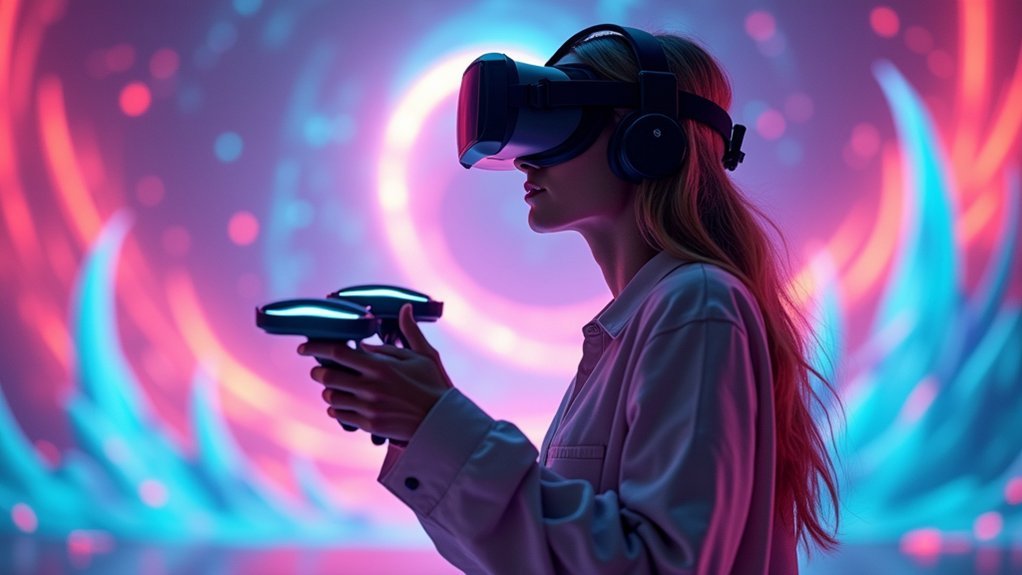
VR motion controllers serve as your digital hands, translating every physical gesture into precise virtual actions. These handheld devices transform your real-world movements into seamless interactions within virtual environments, creating an intuitive bridge between physical and digital worlds.
Your VR controllers utilize sophisticated sensor arrays, including gyroscopes and accelerometers, to track hand position and orientation in real-time. This precise tracking guarantees accurate representation of your movements, enabling natural navigation through virtual spaces.
Sophisticated sensor technology captures your every movement, transforming physical gestures into precise virtual actions through real-time tracking systems.
The controllers feature multiple input methods—buttons, triggers, thumbsticks, and touchpads—allowing you to perform diverse actions from simple selections to complex gestures.
Integrated haptic feedback technology enhances your user experience by delivering tactile sensations like vibrations and resistance, making virtual interactions feel remarkably realistic and immersive during your VR sessions.
Walking-in-Place Techniques for Natural VR Navigation
While controllers enable precise hand interactions, your legs require a different approach for natural movement through virtual spaces. Walking-in-place stands out among VR locomotion techniques by translating your stationary limb movements into virtual motion at speeds ranging 1.4 to 3 m/s. This method creates an immersive experience that mimics natural walking patterns.
| Aspect | Walking-in-Place | Traditional Controllers |
|---|---|---|
| Speed Range | 1.4-3 m/s | Variable |
| Natural Feel | High mimicry | Artificial input |
| Learning Curve | Intuitive | Moderate |
However, you’ll need to take into account user comfort carefully, as some experience psychophysical discomfort. Research shows walking-based navigation remains prevalent in VR, though user feedback reveals varying effectiveness levels. You may need adaptations to accommodate individual preferences while maintaining the technique’s immersive qualities.
Joystick and Thumbstick-Based Movement Systems
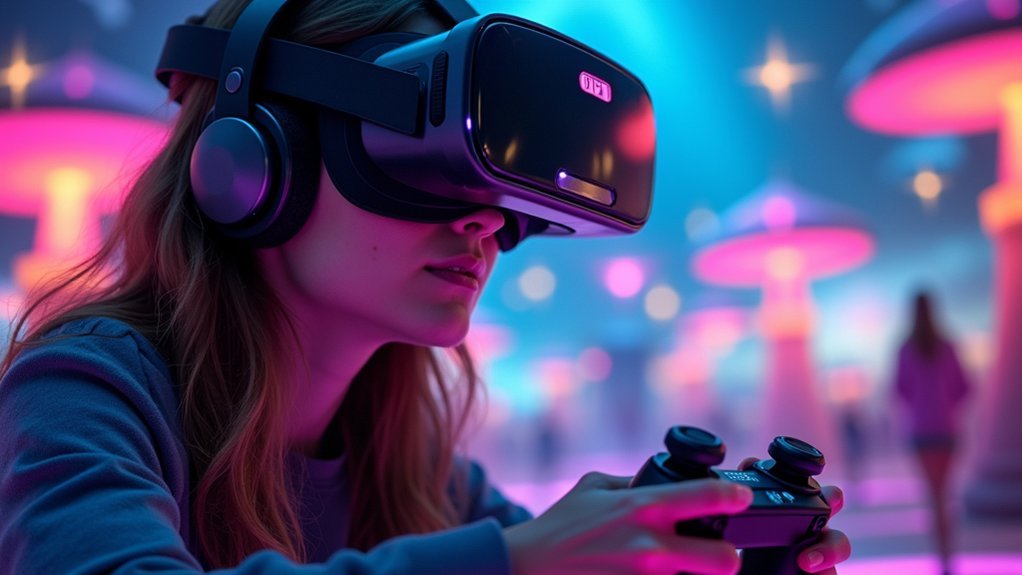
While walking-in-place offers natural movement, you’ll find joystick and thumbstick controls provide unmatched precision for steering VR environments.
You can achieve exact directional control by simply tilting the stick, with your thumb pressure directly translating to movement velocity.
This system lets you fine-tune your speed from a gentle walk to full sprint, giving you complete mastery over your virtual locomotion.
Precision Movement Control
When you’re maneuvering complex virtual environments, precision becomes paramount—and that’s where joystick and thumbstick-based movement systems excel.
These precision movement control mechanisms translate your thumb’s subtle movements into accurate directional inputs, giving you granular control over your VR motion. Unlike broad physical movements and actions required by room-scale tracking, thumbstick systems let you make micro-adjustments with remarkable accuracy.
The variable speed control responds to pressure and position, allowing you to creep slowly around corners or sprint across open terrain.
HTC Vive controllers and similar devices enhance this precision through integrated haptic feedback, providing tactile confirmation of your movements. This combination of fine motor control and sensory feedback creates an intuitive navigation system that reduces fatigue while maintaining the immersive qualities essential for extended virtual exploration sessions.
Speed Regulation Mechanics
As you push your thumbstick forward, the sophisticated speed regulation mechanics instantly translate the degree of your input into precise velocity control within the virtual environment. Your joystick’s built-in sensors detect both angle and distance of movement, creating seamless conversion between physical input and digital response.
| Thumbstick Position | Speed (m/s) | Movement Type | Haptic Response |
|---|---|---|---|
| Light Push | 1.4 | Slow Walk | Minimal Vibration |
| Medium Tilt | 2.2 | Normal Pace | Moderate Feedback |
| Full Extension | 3.0 | Fast Movement | Strong Resistance |
The speed regulation system feels intuitive because it mirrors natural movement expectations. You’ll find the shift from traditional gaming surprisingly smooth, as familiar joystick controls provide customizable navigation. Integrated haptic feedback enhances this experience by delivering physical sensations that correspond directly to your chosen velocity and direction.
Teleportation Methods for Seamless Virtual Travel
You’ll find teleportation offers a fundamentally different approach to VR navigation through point-and-click systems that instantly transport you to your desired destination.
This method eliminates motion sickness concerns by removing continuous movement, but it creates an ongoing tension between user comfort and maintaining immersion in virtual worlds.
The instant movement mechanics provide efficient travel while potentially breaking the natural flow of exploration that makes virtual environments feel authentic.
Point-and-Click Navigation Systems
While traditional VR locomotion can trigger motion sickness and discomfort, point-and-click navigation systems offer an elegant solution that lets you instantly teleport to your desired destination.
You’ll simply point to a specific location within the virtual space and transport there immediately, bypassing the psychophysical effects that cause nausea during movement.
This teleportation method enhances your user experience by dramatically improving navigation efficiency and task completion times.
You’ll find it particularly valuable in expansive virtual worlds where quick shifts between distant points are essential.
While some users report that teleportation can disrupt immersion due to the lack of physical movement sensation, most favor it for speed and ease of use, especially during time-sensitive tasks in complex VR environments.
Instant Movement Mechanics
When you need to traverse vast virtual landscapes efficiently, instant movement mechanics transform how you experience digital spaces by eliminating the traditional constraints of physical locomotion.
Teleportation allows you to select destinations visually and achieve instantaneous movement without walking. You’ll simply point to your desired location and jump there immediately.
While this method dramatically improves navigation speed and accessibility for users with mobility impairments, it can disrupt immersion through jarring visual shifts. The stark contrast between selecting a point and suddenly appearing there feels unnatural compared to fluid movement.
However, you can enhance the user experience by incorporating haptic feedback and audio cues during teleportation. These sensory confirmations reduce disorientation and help maintain immersion despite the artificial nature of instant movement mechanics.
Immersion Vs Comfort Trade-Offs
The fundamental challenge of VR locomotion centers on balancing immersion with user comfort, and teleportation sits at the heart of this debate.
When you use teleportation methods, you’ll experience exceptional comfort and motion sickness prevention, but you’re trading away spatial awareness and environmental connection.
Research shows that while you can navigate expansive worlds efficiently without physical exertion, this convenience comes at immersion’s expense.
You’ll find teleportation particularly valuable if you’re sensitive to motion sickness, as it eliminates the psychophysical discomfort associated with continuous movement.
However, you’ll notice decreased spatial understanding compared to walking-in-place techniques.
Your preference ultimately depends on whether you prioritize seamless, comfortable navigation or deeper environmental immersion during your virtual experiences.
Hand Tracking and Gesture-Based Motion Control
As virtual reality technology advances, hand tracking emerges as one of the most revolutionary developments in user interaction. You’ll discover that sensors and cameras detect your hand movements and gestures, eliminating the need for physical controllers. This gesture-based motion control lets you grab, point, and swipe naturally, creating seamless interactions within virtual environments.
Advanced systems recognize over 20 distinct hand gestures simultaneously, delivering remarkable precision. You’ll experience enhanced immersion when haptic feedback simulates the tactile sensation of touching virtual objects.
This technology greatly improves user experience by making VR more intuitive and accessible. Those with disabilities who struggle with traditional controllers find gesture-based controls particularly beneficial, as natural hand movements replace complex button combinations and joystick manipulations.
Room-Scale Movement and Physical Space Integration
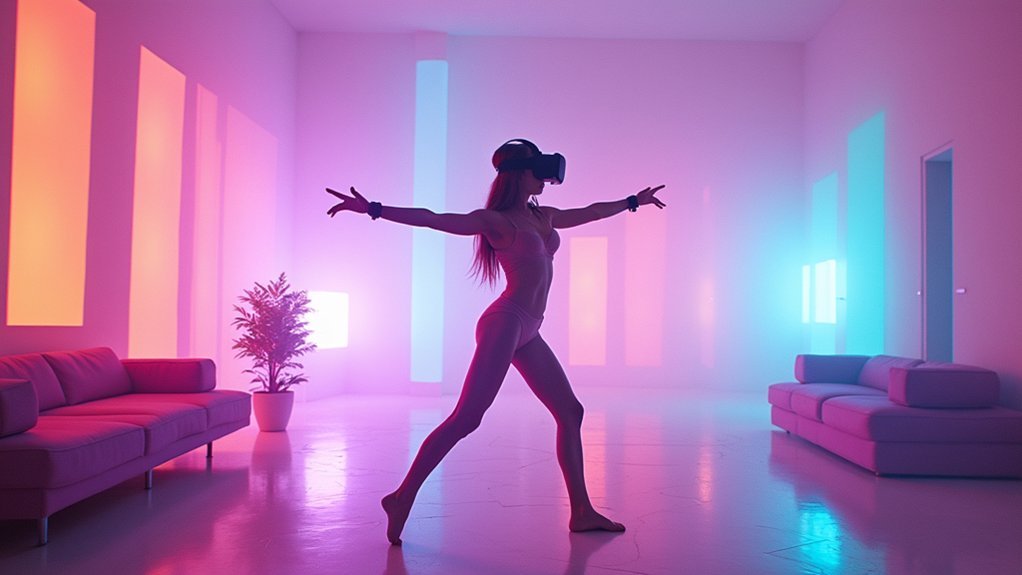
Beyond individual hand movements, room-scale VR technology transforms your entire body into a controller by tracking your physical movements throughout a designated play area.
VR systems like the HTC Vive provide 360° tracking within your physical space, creating seamless integration between real and virtual worlds.
This natural locomotion method greatly enhances your user experience while reducing motion sickness compared to traditional movement techniques. You’ll need at least 1.5m x 1.5m for ideal tracking performance.
Key benefits of room-scale movement include:
- Natural navigation – Walk physically through virtual environments without artificial controls
- Enhanced spatial awareness – Your body maintains connection to real-world positioning
- Reduced discomfort – Physical movement eliminates disconnect between visual and vestibular systems
- Improved interaction – Motion-tracked controllers enable natural object manipulation within your play space
Haptic Feedback and Tactile Motion Enhancement
When you grip a virtual sword or touch a digital surface, haptic feedback technology transforms these interactions from mere button presses into tangible sensations that your hands can actually feel. This revolutionary feature uses vibration motors in VR controllers to simulate real-world textures, impacts, and resistance, creating truly immersive environments.
| Haptic Feature | User Experience Benefit | VR Application |
|---|---|---|
| Impact Simulation | Feel weapon collisions | Combat games |
| Texture Rendering | Sense surface materials | Exploration sims |
| Weight Feedback | Experience object mass | Training programs |
| Adaptive Response | Dynamic environmental feedback | Interactive narratives |
You’ll notice how haptic feedback bridges the gap between physical and digital domains. Research confirms that when tactile sensations align with your virtual reality actions, you’ll experience deeper emotional connections and markedly enhanced satisfaction throughout your VR journey.
Accessibility Considerations for Diverse User Needs
Although virtual reality promises immersive experiences for everyone, traditional VR systems often overlook users with visual impairments who navigate digital worlds through fundamentally different sensory channels.
When designing accessible VR environments, you’ll need to reimagine how users move through virtual spaces using alternative feedback methods.
Research reveals three effective locomotion techniques for blind users:
- Arm Swinging – Enhances movement awareness through natural gestures
- Linear Movement – Provides straightforward directional control
- Point & Teleport – Offers fastest task completion with simplified navigation
- Haptic white canes – Deliver essential spatial information through tactile feedback
You’ll discover that while these methods show no significant performance differences, user preferences vary widely.
Effective accessibility requires integrating robust haptic feedback systems that transform spatial information into tactile cues, ensuring VR remains inclusive for diverse abilities.
Future Innovations in VR Locomotion Technology
The accessibility innovations pioneered for users with visual impairments are now catalyzing broader breakthroughs in VR locomotion technology.
You’ll experience revolutionary haptic feedback systems that’ll simulate diverse textures and physical impacts, making virtual interactions feel remarkably authentic. Advanced VR controllers will adapt to your behavior through integrated AI, personalizing your experience and enhancing user interaction quality.
Ergonomic designs will eliminate fatigue during extended sessions, while wireless innovations free you from restrictive cables. You’ll navigate virtual worlds with unprecedented mobility and simplified setup processes.
Specialized controllers are emerging for specific applications like fitness and professional simulations, tailoring experiences to unique scenarios.
These technological advances collectively transform how you’ll move, interact, and immerse yourself within virtual environments, creating more intuitive and engaging VR locomotion experiences.
Frequently Asked Questions
What Are Motion Controls in VR?
You’ll use motion controls in VR to interact with virtual environments through physical gestures and movements. They track your hands and body using sensors, letting you grab, throw, and manipulate objects naturally.
How Much Does Virtual Reality Training Cost?
You’ll spend $300-$1,500 for basic VR setups, while professional training programs cost $5,000-$50,000. Custom solutions can exceed $100,000, plus you’ll need compatible computers ($1,000-$3,000) and ongoing subscription fees ($50-$500 monthly).
What Common Movement Options Are Available in a Virtual Reality VR Experience?
You can move in VR using walking-in-place, controller joysticks, teleportation pointing, arm swinging motions, or steering-based techniques. Each method offers different levels of immersion and comfort for traversing virtual spaces.
What Are Three Disadvantages to VR Training?
You’ll face motion sickness from disorienting movement mechanics, encounter high costs for hardware and software setup, and deal with technical glitches that disrupt your learning experience and frustrate your training progress.

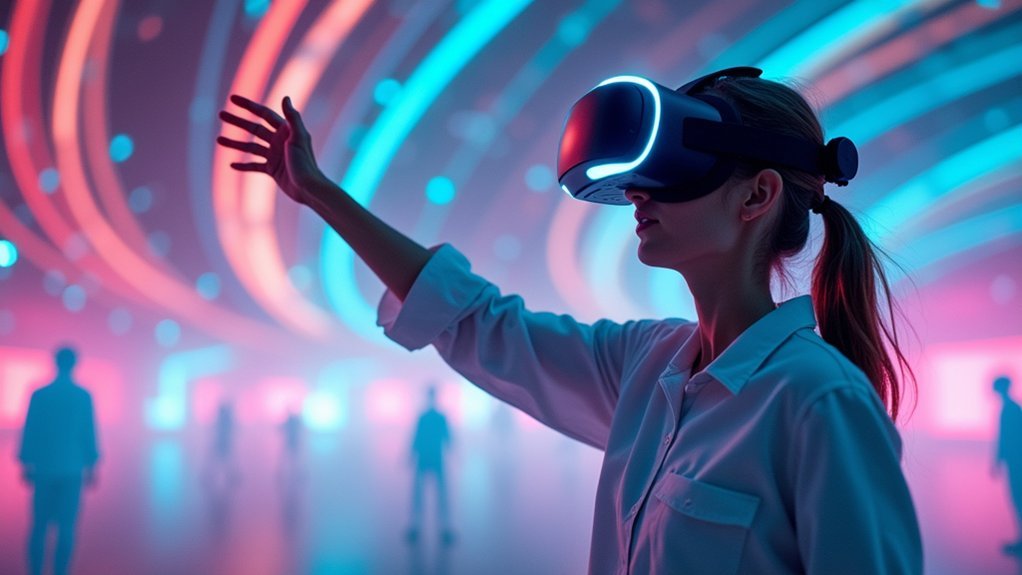


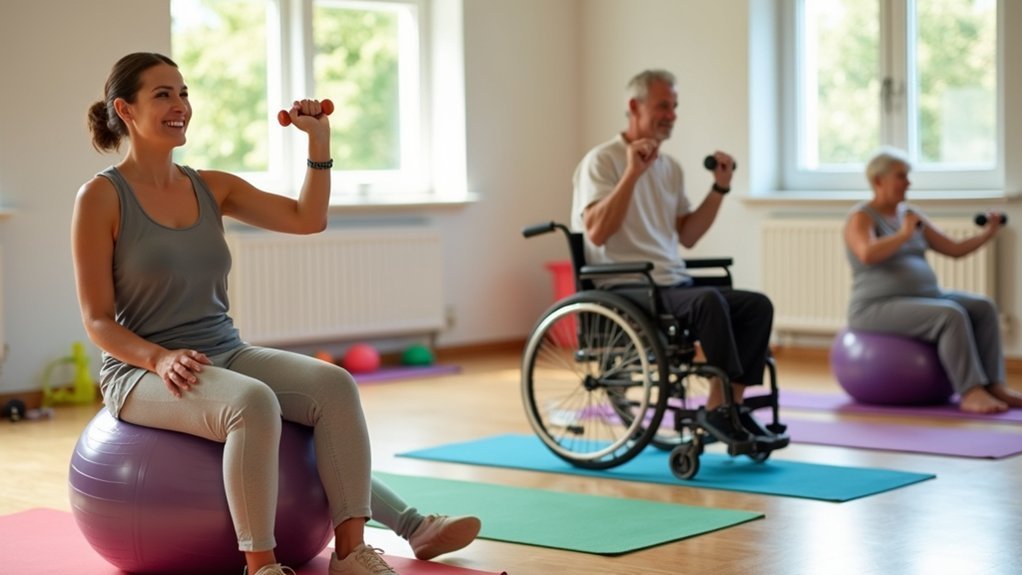
Leave a Reply